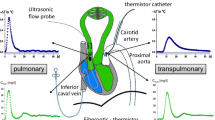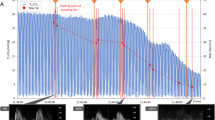Abstract
This study was designed to determine the effects of thromboxane A2 (TxA2) on the distribution of vascular resistance, lung weight, and microvascular permeability in isolated dog lungs perfused at a constant pressure with autologous blood. The stable TxA2 analogue (STA2; 30 μg, n = 5) caused an increase in pulmonary capillary pressure (Pc) assessed as double-occlusion pressure to 14.0 ± 0.4 mmHg from the baseline of 7.9 ± 0.3 mmHg with progressive lung weight gain. Pulmonary vascular resistance increased threefold exclusively due to pulmonary venoconstriction. Pulmonary venoconstriction was confirmed in lungs perfused in a reverse direction from the pulmonary vein to the artery (n = 5), as evidenced by marked precapillary vasoconstriction and a sustained lung weight loss. Furthermore, in lungs perfused at a constant blood flow (n = 5), STA2 also caused selective pulmonary venoconstriction. Vascular permeability measured by the capillary filtration coefficient and the isogravimetric Pc at 30 and 60 min after STA2 infusion did not change significantly from baseline in any lungs studied. Moreover, elevation of Pc by raising the venous reservoir of the intact lobes (n = 5) to the same level as the STA2 lungs caused a greater or similar weight gain compared with the STA2 lungs. Thus, we conclude that TxA2 constricts selectively the pulmonary vein resulting in an increase in Pc and lung weight gain without significant changes in vascular permeability in isolated blood-perfused dog lungs.
Similar content being viewed by others
References
Barman SA, Senteno E, Smith S, Taylor AE (1989) Acetylcholine's effect on vascular resistance and compliance in the pulmonary circulation. J Appl Physiol 67:1495–1503
Barnard JW, Ward RA, Adkins WK, Taylor AE (1992) Characterization of thromboxane and prostacyclin effects on pulmonary vascular resistance. J Appl Physiol 72:1845–1853
Bowers RE, Ellis EF, Brigham KL, Oates JA (1979) Effects of prostaglandin cyclic end operoxides on the lung circulation of unanesthetized sheep. J Clin Invest 63:131–137
Brigham KL, Duke S (1985) Prostaglandins and lung disease: adult respiratory distress syndrome. Semin Respir Med 7:11–16
Brigham KL, Meyrick B (1986) State of the art: endotoxin and lung injury. Am Rev Respir Dis 133:913–927
Drake R, Gaar KA, Taylor AE (1978) Estimation of the filtration coefficient of pulmonary exchange vessels. Am J Physiol 234:H266-H274
Garcia-Szabo RR, Peterson MB, Watkins WD, Bizios R, Kong DL, Malik AB (1983) Thromboxane generation after thrombin: protective effect of thromboxane synthetase inhibition on lung fluid balance. Circ Res 53:214–222
Klausner JM, Peterson IS, Goldman G, Kobzik L, Valeri CR, Shepro D, Hechtman HB (1989) Thromboxane A2 mediates increased pulmonary microvascular permeability following limb ischemia. Circ Res 64:1178–1189
Kubo K, Kobayashi T (1985) Effects of OKY-046, a selective thromboxane synthetase inhibitor, on endotoxin-induced lung injury in unanesthetized sheep. Am Rev Respir Dis 132:494–499
Littner MR, Lott FD (1989) Edema from cyclooxygenase products of endogenous arachidonic acid in isolated lung. J Appl Physiol 67:846–855
Loyd JE, Newman JH, English DE, Ogletree ML, Meyrick BD, Brigham KL (1983) Lung vascular effects of phorbol myristate acetate in awake sheep. J Appl Physiol 54:267–276
Mais DE, Saussy DL Jr, Chaikhouni A, Kochel PJ, Knapp KR, Hamanaka N, Halushka PV (1985) Pharmacologic characterization of human and canine thromboxane A2/prostaglandin H2 receptors in platelets and blood vessels: evidence for different receptors. J Pharmacol Exp Ther 233:418–424
Malik AB (1983) Pulmonary microembolism. Physiol Rev 63:1114–1207
Morel DR, Zapol WM, Thomas SJ, Kitain EM, Robinson DR, Moss J, Chenoweth DE, Lowenstein E (1987) C5a and thromboxane generation associated with pulmonary vaso- and bronchoconstriction during protamine reversal of heparin. Anesthesiology 65:597–604
Oates JA, FitzGerald GA, Branch RA, Jackson EK, Knapp HR, Roberts LJ (1988) Clinical implication of prostaglandin and thromboxane A2 formation. N Engl J Med 319:689–698
Ogletree ML, Brigham KL (1980) Arachidonate raises vascular resistance but not permeability in lungs of awake sheep. J Appl Physiol 48:581–586
Parker JC, Townsley MI, Rippe B, Taylor AE, Thigpen J (1984) Increased microvascular permeability in dog lungs, due to high peak airway pressures. J Appl Physiol 57:1809–1816
Seeger W, Ernst CH, Walmrath D, Neuhof H, Roka L (1985) Influence of the thromboxane antagonist BM 13.177 on the arachidonic acid-induced increase in pulmonary vascular resistance and permeability in rabbit lungs. Thrombosis Res 40:793–805
Shibamoto T, Parker JC, Taylor AE, Townsley MI (1990) Derecruitment of filtration surface area in paraquat-injured isolated dog lungs. J Appl Physiol 68:1581–1589
Shibamoto T, Hayashi T Jr, Sawano F, Saeki Y, Matsuda Y, Kawamoto M, Koyama S (1992) Pulmonary vascular response to anaphylaxis in isolated canine lungs. Am J Physiol 263:R1024-R1029
Taylor AE, Parker JC (1985) Pulmonary interstitial spaces and lymphatics. In: Handbook of Physiology. The Respiratory System. Circulation and Nonrespiratory Functions. American Physiological Society, Bethesda, MD, pp 162–230
Townsley MI, Korthuis RJ, Taylor AE (1985) Effects of arachidonate on permeability and resistance in canine lungs. J Appl Physiol 58:206–210
Townsley MI, Korthuis RJ, Rippe B, Parker JC, Taylor AE (1986) Validation of double vascular occlusion method for Pc,i in the lung and skeletal muscle. J Appl Physiol 61:127–132
Wakerlin GE, Benson GV, Pearl RG (1991) A thromboxane analog increases pulmonary capillary pressure but not permeability in the perfused rabbit lung. Anesthesiology 75:475–480
Win R, Nadir HB, Harker L, Hilderbrandt J (1983) Thromboxane A2 mediates lung vasoconstriction but not permeability after endotoxin. J Clin Invest 72:911–918
Yoshimura K, Todd ML, Pier KG, Rubin LJ (1989) Role of venoconstriction in thromboxane-induced pulmonary hypertension and edema in lambs. J Appl Physiol 66:929–935
Yoshimura K, Todd ML, Pier KG, Rubin LJ (1989) Effects of a thromboxane A2 analogue and prostacyclin on lung fluid balance in newborn lambs. Circ Res 65:1409–1416
Author information
Authors and Affiliations
Additional information
Offprint requests to: T. Shibamoto
Rights and permissions
About this article
Cite this article
Shibamoto, T., Wang, H.G., Yamaguchi, Y. et al. Effects of thromboxane A2 analogue on vascular resistance distribution and permeability in isolated blood-perfused dog lungs. Lung 173, 209–221 (1995). https://doi.org/10.1007/BF00181873
Accepted:
Issue Date:
DOI: https://doi.org/10.1007/BF00181873




